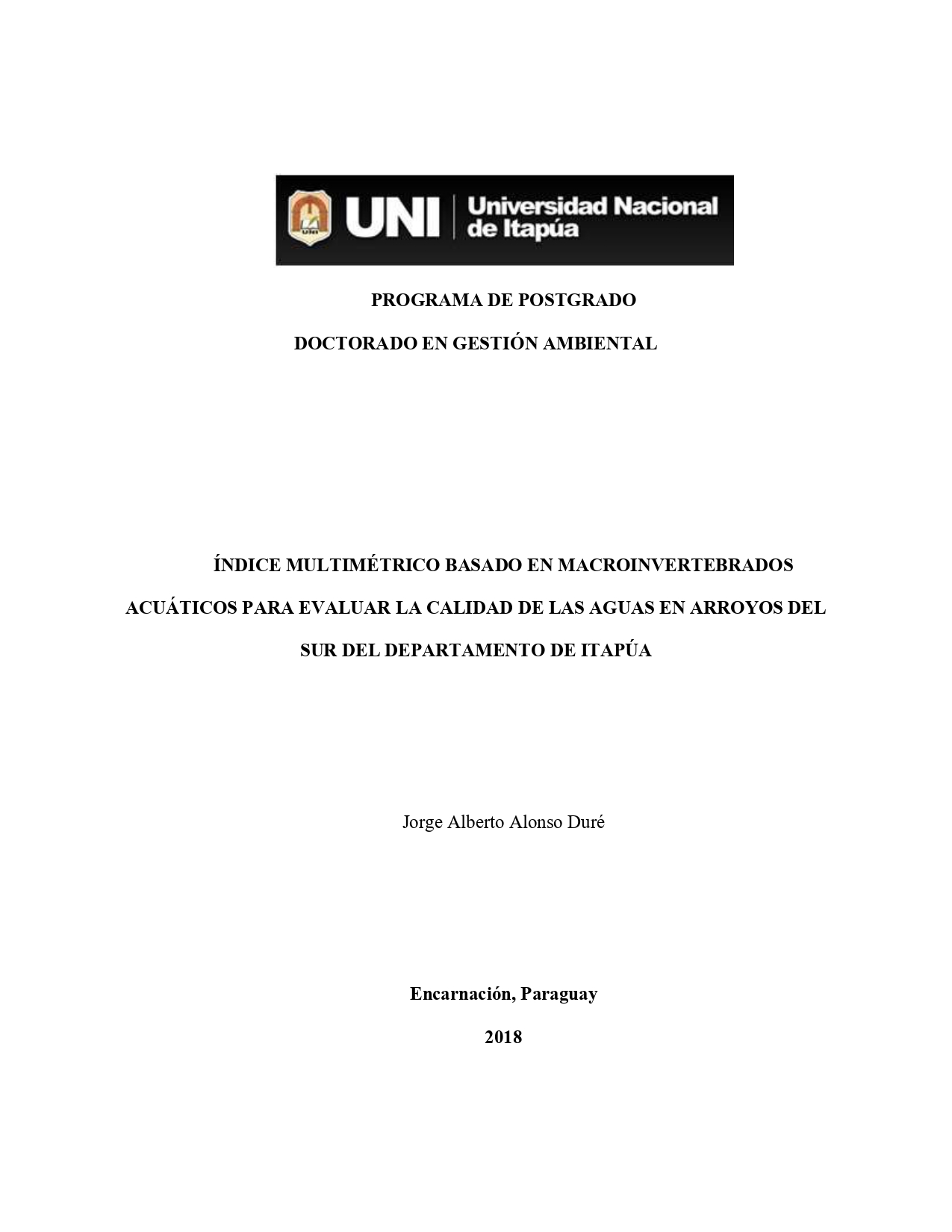Índice multimétrico basado en macroinvertebrados acuáticos para evaluar la calidad de las aguas en arroyos del sur del Departamento de Itapúa
Share
Metadata
Show full item recordAuthor(s)
Alonso Duré, Jorge AlbertoAdviser
Rodríguez, Estelvina
Date of publishing
2018-11-17Type of publication
info:eu-repo/semantics/doctoralThesisSubject(s)
Biodiversidad
Calidad del agua
Índice multimétrico
Itapúa
Biodiversity
Water quality
Multimetric index
Itapúa
Calidad del agua
Índice multimétrico
Itapúa
Biodiversity
Water quality
Multimetric index
Itapúa
Abstract
La contaminación de las aguas dulces superficiales es uno de los grandes problemas ambientales del mundo, siendo necesario su monitoreo adecuado. Por tal motivo, la investigación tuvo como objetivo principal desarrollar un índice multimétrico basado en macroinvertebrados para la evaluación de la calidad de los arroyos del sur de Itapúa (IMSI), con el fin de aportar metodológicamente en la evaluación y monitoreo de los arroyos del país. Para ello, se realizó análisis de la calidad de las aguas (entre septiembre de 2016 a julio de 2017) en las cuencas de Aguapey (E1, E2, E3 y E4), Tacuary (E5, E6 y E7), Caraguata (E8) y Quiteria (E9), considerando los parámetros físicoquímicos (utilizando el índice simplificado de calidad de agua - ISQA y resolución Nº 222/02 de la SEAM), la biodiversidad a nivel familia (abundancia, índices de Simpson, Shannon, Margalef, Pielou) y el método BMWP-Ag (Biological Monitoring Working Party – Aguapey). Se seleccionaron los sitios de referencias y perturbados, considerando distintos grados de intervención antrópica y los resultados fisicoquímicos. Fueron analizados 11 métricas posibles, siendo seleccionadas 6 (abundancia, número de taxones, índices de Shannon, BMWP-Ag, % Chiromonidos + hirudineos, y % Odonatos), considerando los datos estadísticos, se determinó el sistema de puntuación e interpretación del IMSI. Los resultados indican que la abundancia y la diversidad fueron influenciadas por la contaminación orgánica, registrándose 48 familias – taxones de 14 órdenes, siendo los más abundantes los ephenopteros, hemípteros, coleópteros, dípteros e hirudineas. Del análisis de los datos obtenidos se determinó que las aguas de las cuencas se encontraron medianamente contaminadas, siendo los más afectados los arroyos Cai Puente (E4) y Lima (E7), debido a las actividades urbanas y agro industriales. Se encontró elevada correlación positiva del IMSI, BMWP-Ag e ISQA. Se concluye que la herramienta con variables multimétrica basado en macroinvertebrados permitió valorar en forma sistémica la calidad de los arroyos de la región, demostrando de esta manera que podría constituirse en una herramienta eficaz para el monitoreo de los mismos y así, poder contribuir en la gestión de los recursos hídricos del país. The pollution of superficial fresh water is a serious environmental problem in the world, so its adequate monitoring is necessary. The main objective of this research was to develop a multimetric index based on macroinvertebrates for the assessment of the quality of the streams in the south of Itapúa (IMSI) with the purpose of contributing methodologically in the evaluation and monitoring of the country's streams. For this, water quality analysis was conducted (from September 2016 to July 2017) in the Aguapey basins (E1, E2, E3 and E4), Tacuary (E5, E6 and E7), Caraguata (E8) and Quiteria (E9), considering the physicochemical parameters (using the Simplified Index Water Quality (ISQA) and Res. Nº 222/02 from SEAM), biodiversity at the family level (abundance, Simpson, Shannon, Margalef, Pielou indexes) and the BMWP-Ag method (Biological Monitoring Working Party - Aguapey). Reference and disturbed sites were selected considering different degrees of anthropic intervention and physicochemical results. 11 possible metrics were analyzed, 6 being selected (abundance, number of taxa, Shannon indexes, BMWP-Ag, % Chironomidae+ hirudinea, and % Odonata); based on the statistical data, the system of scoring and interpretation of the IMSI was determined. The results indicate that both abundance and diversity were influenced by organic contamination, registering 48 families - taxa of 14 orders, being the most abundant ephenoptera, hemiptera, coleoptera, diptera and hirudinea. From the analysis of the data obtained, it was determined that the water of the basins was moderately contaminated, being the most affected Cai Puente (E4) and Lima (E7) streams, due to urban and agro-industrial activities. High positive correlation of the IMSI, BMWP-Ag and ISQA was found. It is concluded that the tool with multimetric variables based on macroinvertebrates permitted to evaluate systemically the quality of the streams of the region, demonstrating this way that it could be an effective tool for the monitoring of the creeks and thus be able to contribute in the management of the country's water resources.






